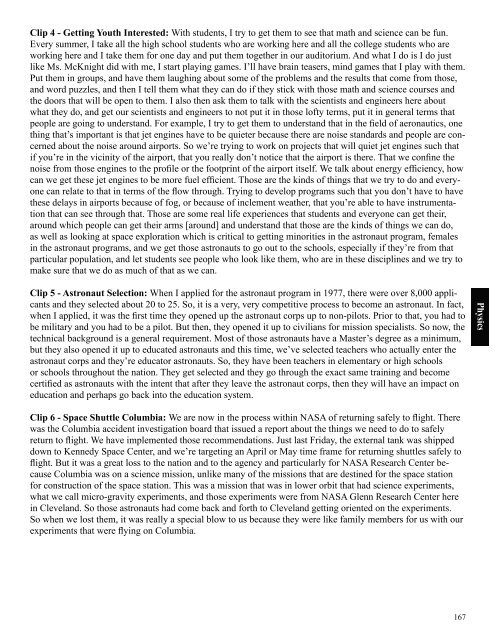ScienceMakers Toolkit Manual - The History Makers
ScienceMakers Toolkit Manual - The History Makers
ScienceMakers Toolkit Manual - The History Makers
You also want an ePaper? Increase the reach of your titles
YUMPU automatically turns print PDFs into web optimized ePapers that Google loves.
Clip 4 - Getting Youth Interested: With students, I try to get them to see that math and science can be fun.<br />
Every summer, I take all the high school students who are working here and all the college students who are<br />
working here and I take them for one day and put them together in our auditorium. And what I do is I do just<br />
like Ms. McKnight did with me, I start playing games. I’ll have brain teasers, mind games that I play with them.<br />
Put them in groups, and have them laughing about some of the problems and the results that come from those,<br />
and word puzzles, and then I tell them what they can do if they stick with those math and science courses and<br />
the doors that will be open to them. I also then ask them to talk with the scientists and engineers here about<br />
what they do, and get our scientists and engineers to not put it in those lofty terms, put it in general terms that<br />
people are going to understand. For example, I try to get them to understand that in the fi eld of aeronautics, one<br />
thing that’s important is that jet engines have to be quieter because there are noise standards and people are concerned<br />
about the noise around airports. So we’re trying to work on projects that will quiet jet engines such that<br />
if you’re in the vicinity of the airport, that you really don’t notice that the airport is there. That we confi ne the<br />
noise from those engines to the profi le or the footprint of the airport itself. We talk about energy effi ciency, how<br />
can we get these jet engines to be more fuel effi cient. Those are the kinds of things that we try to do and everyone<br />
can relate to that in terms of the fl ow through. Trying to develop programs such that you don’t have to have<br />
these delays in airports because of fog, or because of inclement weather, that you’re able to have instrumentation<br />
that can see through that. Those are some real life experiences that students and everyone can get their,<br />
around which people can get their arms [around] and understand that those are the kinds of things we can do,<br />
as well as looking at space exploration which is critical to getting minorities in the astronaut program, females<br />
in the astronaut programs, and we get those astronauts to go out to the schools, especially if they’re from that<br />
particular population, and let students see people who look like them, who are in these disciplines and we try to<br />
make sure that we do as much of that as we can.<br />
Clip 5 - Astronaut Selection: When I applied for the astronaut program in 1977, there were over 8,000 applicants<br />
and they selected about 20 to 25. So, it is a very, very competitive process to become an astronaut. In fact,<br />
when I applied, it was the fi rst time they opened up the astronaut corps up to non-pilots. Prior to that, you had to<br />
be military and you had to be a pilot. But then, they opened it up to civilians for mission specialists. So now, the<br />
technical background is a general requirement. Most of those astronauts have a Master’s degree as a minimum,<br />
but they also opened it up to educated astronauts and this time, we’ve selected teachers who actually enter the<br />
astronaut corps and they’re educator astronauts. So, they have been teachers in elementary or high schools<br />
or schools throughout the nation. <strong>The</strong>y get selected and they go through the exact same training and become<br />
certifi ed as astronauts with the intent that after they leave the astronaut corps, then they will have an impact on<br />
education and perhaps go back into the education system.<br />
Clip 6 - Space Shuttle Columbia: We are now in the process within NASA of returning safely to fl ight. <strong>The</strong>re<br />
was the Columbia accident investigation board that issued a report about the things we need to do to safely<br />
return to fl ight. We have implemented those recommendations. Just last Friday, the external tank was shipped<br />
down to Kennedy Space Center, and we’re targeting an April or May time frame for returning shuttles safely to<br />
fl ight. But it was a great loss to the nation and to the agency and particularly for NASA Research Center because<br />
Columbia was on a science mission, unlike many of the missions that are destined for the space station<br />
for construction of the space station. This was a mission that was in lower orbit that had science experiments,<br />
what we call micro-gravity experiments, and those experiments were from NASA Glenn Research Center here<br />
in Cleveland. So those astronauts had come back and forth to Cleveland getting oriented on the experiments.<br />
So when we lost them, it was really a special blow to us because they were like family members for us with our<br />
experiments that were fl ying on Columbia.<br />
167<br />
Physics










